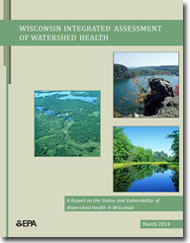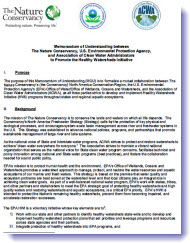Water: Healthy Watersheds
Healthy Watersheds
Healthy Watersheds (HW) Highlights
- Healthy Watersheds Consortium Grant Request for Proposals (RFP) has been posted
- Alabama & Mobile Bay Basin Integrated Assessment of Watershed Health
- Wisconsin Integrated Assessment of Watershed Health
- California Integrated Assessment of Watershed Health (PDF) (118 pp, 4.5MB, About PDF)
- Memorandum of Understanding to Promote the Healthy Watersheds Initiative
- Healthy Watersheds Newsletter
- Economic Benefits of Healthy Watersheds
- Healthy Watersheds Technical Document
- Healthy Watersheds Workshop Synthesis
- Healthy Watersheds Initiative: National Framework and Action Plan (Action Plan), 2011
- Healthy Watersheds Integrated Assessments Workshop Proceedings, Speaker Presentations, and Speaker Program Summaries
- EPA's Healthy Watersheds Initiative (PDF) (5 pp, 5.8MB, About PDF)
Aquatic ecosystems are dynamic, interconnected in the landscape, and influenced by naturally varying lake levels, groundwater interactions, and streamflows, as well as other
natural variations in watersheds, such as forest fires. These dynamics, along with the landscape and climatic setting, largely determine the types of aquatic habitats and
species endemic to a particular area. Effective protection of aquatic ecosystems recognizes their connectivity and dynamics at multiple spatial/temporal scales.
Human activities have greatly altered aquatic ecosystems. Pollution and water quality problems continue to be of concern, but other significant impacts include loss and fragmentation of habitat, hydrologic alteration, invasive species, and climate change.
- Over the last 50 years, coastal and freshwater wetlands have declined; surface water and groundwater withdrawals have increased by 46%; and non-native fish have established themselves in many watersheds (Heinz Center, 2008).
- A recent national water quality survey of the nation's rivers and streams showed that 55% of the nation's flowing waters are in poor biological condition and 23% are in fair biological condition (U.S. EPA, 2013). Compared to a 2006 survey (U.S. EPA, 2006), which only assessed wadeable streams, 7% fewer stream miles were in good condition.
- Nearly 40% of fish in North American freshwater streams, rivers, and lakes are found to be vulnerable, threatened, or endangered; nearly twice as many as were included on the imperiled list from a similar survey conducted in 1989 (Jelks et al., 2008)
- Rainbow trout habitat loss from warmer water temperatures associated with climate change already has been observed in the southern Appalachians (Flebbe et al., 2006).
EPA created the Healthy Watersheds Program to proactively protect aquatic ecosystems as dynamic systems across landscapes in order to maintain the natural structure and function of ecosystems as intended by Congress in the 1972 Federal Water Pollution Control Act amendments. This systems approach protects aquatic biota and their habitat as well as watershed characteristics and processes that support them such as vegetative riparian corridors and headwaters, hydrology, geomorphology, and natural disturbance regimes. The holistic protection approach provided by the Healthy Watersheds Program is essential for addressing the pervasive threats to healthy watersheds, including loss and fragmentation of habitat, hydrologic alteration, invasive species, and climate change.
This website provides information on Healthy Watersheds, including:
- Healthy Watersheds Program
- Healthy Watersheds Program Publications
- Benefits of Healthy Watersheds
- Identifying Healthy Watersheds
- Integrated Assessments
- Protecting Healthy Watersheds
- Healthy Watersheds & CWA Programs
- Climate Change and Watershed Health
- Related Federal Programs
- Outreach Tools
- Healthy Watersheds Online Forum
- Healthy Watersheds List of References
- National Map of Projects/Programs
- Healthy Watersheds Program Contacts
“The Association of Clean Water Administrators is pleased to be part of EPA’s development of the Healthy Waters Initiative, as we too value holistic approaches to water quality protection and improvement. While much attention has been appropriately paid to degraded waters in the past, it is high time to acknowledge dedicated efforts to protect clean watersheds. EPA’s highlighting of the many benefits healthy watersheds offer – such as wildlife habitat protection, recreation, storm resilience, quality drinking water, improved land use decisions, and sustainability – both supports and complements state efforts.” September 2011
“The Association of Fish and Wildlife Agencies supports the Healthy Watersheds Initiative and its approach to water quality protection and improvement of our nation’s aquatic resources. The initiative will help improve wildlife and fisheries habitat and will increase opportunities for recreational angling – key priorities of state fish and wildlife agencies.” October 2011









